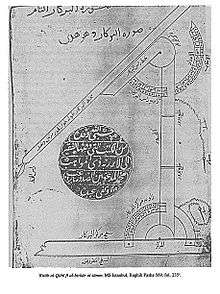Ibn Abi al-Shukr
| Ibn Abī al‐Shukr | |
|---|---|
| Died |
June 1283 CE Maragheh |
| Residence | Islamic civilization |
| Academic background | |
| School or tradition | Maliki |
| Academic work | |
| Era | Islamic Golden Age |
| Main interests | Astronomy, Astrology and Mathematics |
| Notable ideas | New astronomical parameters |
Ibn Abī al‐Shukr (Arabic: ابن ابي الشكر; died 1283 CE) was an Andalusī astronomer, astrologer and mathematician of the Islamic Golden Age. He belonged to the group of astronomers associated with the Maragheh observatory, most notably Nasir al-Din al-Tusi. In astronomy, Ibn Abi al-Shukr carried out a large‐scale project of systematic planetary observations, which led to the development of several new astronomical parameters.[1]
He died in Maragheh in modern-day Iran in June 1283 CE.[1]
Works
Astronomy
His known works on astronomy include:[1]
- Tasṭīḥ al‐asṭurlāb: a description of the construction and use of the astrolabe.
- Maqāla fī istikhrāj taʿdīl al‐nahār wa saʿat al‐mashriq wa‐ʾl‐dāʾir min al‐falak bi‐ṭarīq al‐handasa: a description of the geometrical methods used to determine the meridian line, the rising amplitude, and the revolution of the sphere.
- Risālat al‐Khaṭā wa‐ʾl‐īghūr: a chronological work on the Chinese and Uighur calendars, which was later translated from Arabic and Persian into Chinese.
- Three zijes:
- Tāj al‐azyāj wa‐ghunyat al‐muḥtāj (The crown of astronomical handbooks), also known as Al‐muṣaḥḥaḥ bi‐adwār al‐anwār maʿa al‐raṣad wa‐ʾl‐iʿtibār.
- Adwār al‐anwār madā al‐duhūr wa‐ʾl‐akwār: contains results of the astronomical observations he carried out in Marāgha.
- ʿUmdat al‐ḥāsib wa‐ghunyat al‐ṭālib
- Three commentaries on Ptolemy's Almagest:
- Talkhīṣ al‐Majisṭī (Compendium of the Almagest): based on his observations carried out between 1264 and 1275 CE.
- Khulāṣat al‐Majisṭī (Summary of the Almagest)
- Muqaddimāt tataʿallaq bi‐ḥarakāt al‐kawākib (Prolegomena on the motion of the stars): contains five geometric premises on the planetary motions in the Almagest.
Astrology
Ibn Abī al‐Shukr's astrological works were mainly devoted to horoscopes and planetary conjunctions used to tell the future.[1]
Mathematics
His works deal with geometry and trigonometry. His writings on trigonometry "contain certain original elements".[1]
References
- 1 2 3 4 5 Comes, Mercè (2007). "Ibn Abī al‐Shukr: Muḥyī al‐Milla wa‐ʾl‐Dīn Yaḥyā Abū ʿAbdallāh ibn Muḥammad ibn Abī al‐Shukr al‐Maghribī al‐Andalusī [al‐Qurṭubī]". In Thomas Hockey; et al. The Biographical Encyclopedia of Astronomers. New York: Springer. pp. 548–9. ISBN 978-0-387-31022-0. (PDF version)
